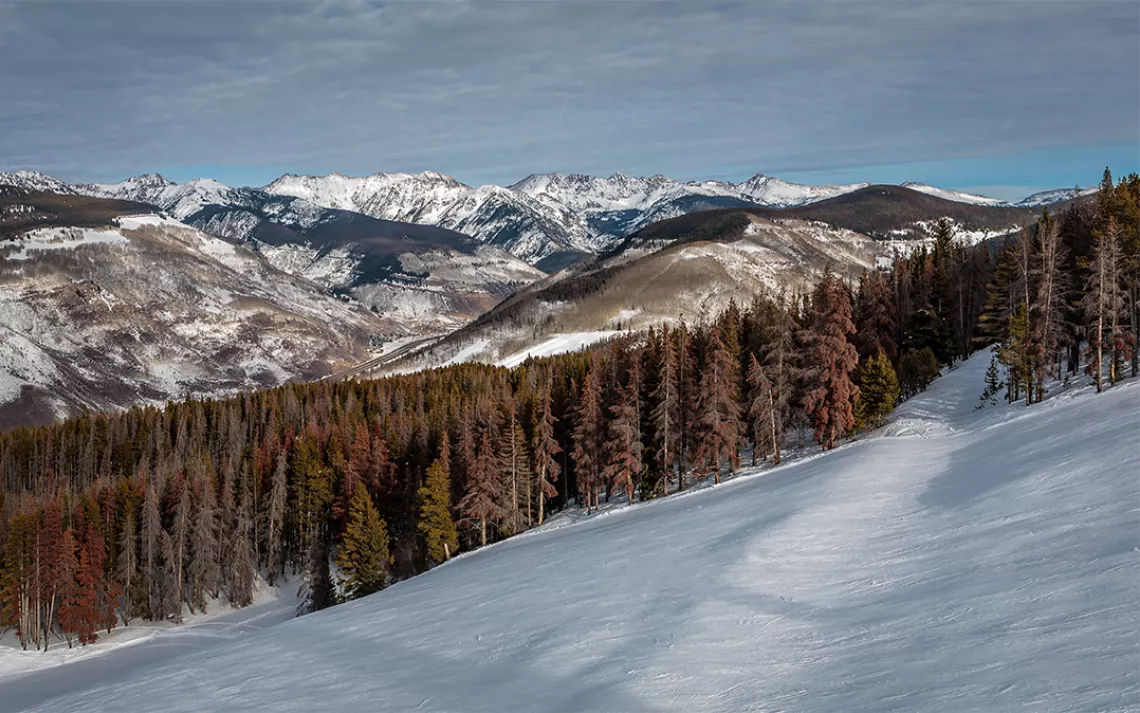A Ski Resort Impacted by Climate Change is Funding Anti-Climate-Action Politicians
When business, politics, and diminishing snowpack collide

Photo by gcosoveanu/iStock
Ski resorts, much like beachfront real estate in Miami, do not have the luxury of ignoring climate change and its financial implications. The relationship between warming temperatures, diminishing snow levels, and fewer skiers is well known. A 2015 Stanford climate and finance analysis of Vail Resorts, Inc., the multinational ski conglomerate, found that the company was in between a rock and a hard place. While increasingly snow-challenged Vail invested heavily in summer recreational projects, 100 percent of its profits still came from winter activities.
That’s why it’s surprising that Vail Resorts PAC—a political fundraising tool seeded with contributions from Vail Resorts CEO Rob Katz and other high-level executives—donated thousands of dollars to politicians who either deny that climate change exists or refuse to take action. Among the beneficiaries were Scott Tipton (R-Colo.), Cory Gardner (R-Colo.), Tom McClintock (R-Calif.), and Chris Stewart (R-Utah). While the PAC also gives to pro-climate-action candidates—Dianne Feinstein (D-Calif.), Ron Wyden (D-Ore.), and Michael Bennett (D-Colo.) among them—the question remains: Why is a company that is already experiencing a climate-induced kneecapping supporting candidates who are working to bring more of the same?
It’s all about the water.
Vail’s response to climate change reflects a company split between short-term economic gains and the long-term health of the industry. If Vail takes the long view, it’s clear that a stable climate is the best thing for its bottom line. But because of erratic snowfall, the company is already scrambling to come up with the water necessary to manufacture snow that used to fall for free out of the sky.
“One of the political risks for a company like Vail Resorts is the retraction of water rights, which is arguably their most critical resource,” Donna Bebb, author of the Stanford report, told me. Artificial snow is energy- and water-intensive, and getting access pits ski resorts against farms, cities, and conservationists during drought years, when water supplies are lowest. In 2012, Vail Resorts reported its water rights as an intangible asset valued at $18.3 million.
To a ski resort that needs water, supporting a politician like Representative Tipton, who believes that the increasingly erratic weather of the last century is just part of “natural cycles,” makes perfect sense. Tipton has twice introduced the Water Rights Protection Act, which seeks to block the U.S. Forest Service from ever taking control over the water rights for ski resorts that operate on public lands. The ski industry has loudly endorsed the act.
So has Representative Gardner, who refuses to take direct action on climate and spearheaded the Outdoor Recreation Jobs and Economic Impact Act—a move that strengthens the outdoor recreation industry relative to agriculture, mining, and timber when it comes to applying for use of public land.
Where environmental stewardship and financial gains go hand in hand, Vail is not shy about climate change. The company cited climate change as the main reason behind its energy-efficiency efforts, for example. Vail has also partnered with Ceres and the World Wildlife Fund on climate-related initiatives and was one of the first signatories on the Business Backs Low-Carbon effort.
Yet, for the most part, the company steers clear of using its powerful stature within the ski industry to influence climate change legislation. Vail Resorts has also been noticeably absent from advocacy efforts by Protect Our Winters (POW), an alliance of pro athletes and winter sports companies that lobbies for climate action.
“We think it’s incredible the work that resorts are doing to reduce their carbon footprint,” said Lindsay Bourgoine, manager of advocacy and campaigns at POW. “We unfortunately feel we are in a time where that’s not enough. We need voices on policy, too.”
Other resorts, like Aspen Ski Company, are more outspoken. Auden Schendler, the company’s VP of sustainability, has made 15 trips to lobby politicians on climate issues in Washington, D.C. The company has also published detailed reports of its energy consumption since 1999 in an effort to be transparent about its energy-reduction efforts, something that Vail does not do.
One clue to Vail’s ambivalent position can be traced back to 2012. Protect Our Winters had just coauthored a report with the Natural Resources Defense Council called “Climate Impacts on the Winter Tourism Economy in the United States.” The report estimated that the $12.2 billion winter tourism industry had already lost out on an estimated $1 billion due to diminished snowfall.
“Count me in the category of someone who is very worried about climate change,” Vail Resorts CEO Rob Katz wrote in an op-ed published a few weeks after the report’s release. “But to the folks trying to alarm people with images of melting snow, here is the dirty little secret: When the effects of climate change really show up, no one will care about skiing at Aspen and Vail.”
 The Magazine of The Sierra Club
The Magazine of The Sierra Club



